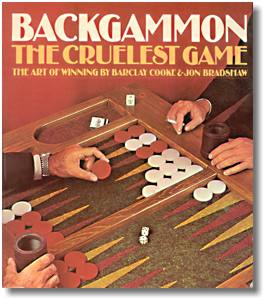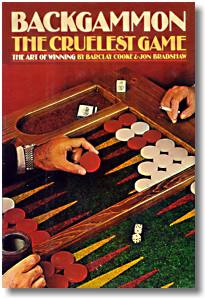 |
|
|

| Backgammon Bibliography | ||||
| Authors | Cooke, Barclay | |||
| Bradshaw, Jon | ||||
| Title | Backgammon - The Cruelest Game | |||
| Subtitle | The Art of Winning | |||
| Cover |


|
|||
|
|
||||
| Year | 1974 | |||
| Pages | 210 | |||
| Publisher | Random House Inc., New York | |||
| Binding | Hardcover (with dustjacket) / Softcover | |||
| ISBN | 0-394-48812-1 (Hardcover) / 0-394-73243-X (Softcover) | |||
| Language | English | |||
| Remarks | Hard- and softcover version published at the same time. | |||
| From the same Author |
Paradoxes and Probabilities, 1978 Championship Backgammon, 1980 |
|||
| Book Reviews |
"It's worth noting, for the interest of the original poster, that probably 90% of
the material in Cooke's first & most widely read book (Cruelest Game) still hold
just fine. [..] Cruelest Game remains an excellent introduction to
thinking seriously about backgammon. [..]
Also -- the book is a pleasure to read. It looks good, is written with style and real personality -- something I find lacking in post-70's backgammon books, especially introductory ones. The classic books of the 70's really help a newcomer to recognize and enjoy the drama and beauty of the game, rather than treating backgammon as some sort of math problem. Cruelest Game, Deyong's 'Playboy's Book', Jacoby/Crawford, -- I don't think they have modern equivalents in print." – Albert Steg, rec.games.backgammon, August 1998 "When I learned BG in 1975, Cooke/Bradshaw was not only considered the best beginning book, but simply the BEST BOOK on the game. (Of course there weren't any advanced books back then...). [..] He was very heavy on defensive tactics, was almost obcessed with building the 20-point, but had a serious distaste for splitting the back checkers (on the 24-point). His cube recommendations ("when in doubt, don't double; when in doubt, take") also tended to be on the conservative side by today's standards. He much preferred to double his opponent out rather than to see a take (and risk the potential frustration if the game turned around): Having said all that, Cooke was definitely (IMO) a proponent of using one's head while playing backgammon. That advice will never go out of style! [..] You could do a lot worse than reading Barclay Cooke." – Chuck Bower, rec.games.backgammon, August 1998 |
|||